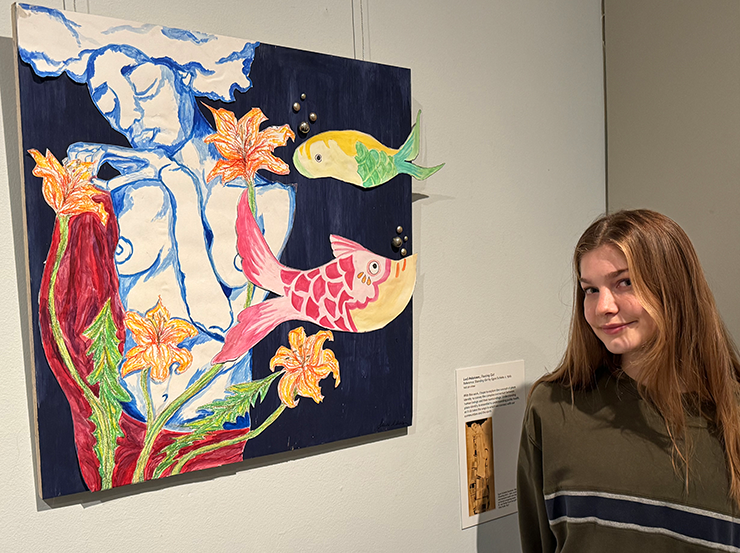In the words of Bukata Hayes, vice president for racial and health equity and chief equity officer at Blue Cross Blue Shield of Minnesota, interpreting art is a “process of reflection (and) reckoning.”
At the Minneapolis Institute of Art (Mia), in the Community Commons gallery, artwork created by students from various area high schools line the walls. These pieces, which are inspired by works in Mia’s collection, focus on racism as a public health crisis.
This is the third year that Blue Cross and Blue Shield of Minnesota has partnered with Mia to produce and display student artwork on this topic. Blue Cross and Blue Shield also supports MinnPost’s Race and Health Equity coverage.
According to Hayes, the Mia partnership was born from the aftermath of the murder of George Floyd and Blue Cross and Blue Shield of Minnesota’s declaration of racism as a public health crisis in 2020. Blue Cross and Blue Shield of Minnesota, Hayes said, “reached out (to Mia) about a partnership about narrative change,” and “expanding the aperture in which we looked at racism as a public health crisis.”
“It’s been truly insightful to see how young people interpret our current condition – what it means for them, what it means for their families and what they see as possibilities going forward,” said Hayes.
Ella Alden Pope, a senior at Highland Park Senior High School, used mixed media in her piece “The Sun Shines Over My Heart Called Home” to depict resilience and hope in the face of environmental racism – a social phenomenon, according to The Climate Reality Project, where Black people and other people of color are more likely to live close to and be exposed to pollution in higher amounts than white people, negatively affecting their health.
Alden Pope’s piece features a photo of two figures – a male presenting figure and a female presenting figure – their arms dotted with white “sponge patches” to evoke mold. The artist statement, displayed next to the piece, clarifies that the models’ “skin was tinted yellow through color balance photography to suggest a sickening health element.”
The other part of the piece is the frame, which is made up of items found in the northside of Minneapolis. Alden Pope gathered these items during her work as a contemporary apprentice at Juxtaposition Arts, a north Minneapolis nonprofit focused on art. The imitation black mold spores are made of clay and acrylic were also grafted onto the frame.
The piece, according to Alden Pope, was inspired by her experiences “growing up in multiple different neighborhoods with multiple different levels of socioeconomic status” with different levels of maintenance.

“I’d really like people to have conversations and to ask questions about where they’ve lived and what conditions they’ve lived in and the privileges that come along with that,” she added.
Alden Pope’s piece was not the only one that highlighted the role of the environment in human health.
“I chose to title my piece ‘Floating Girl’ because of the sense of disconnect I think a lot of people have in relation to their physical environment,” said Luci Aslakson, a senior at St. Paul Conservatory for Performing Artists, whose piece was inspired by Egon Schiele’s “Standing Girl.” “‘Floating Girl’ features a figure adrift with watercolor fish surrounding her, along with four orange lilies.
“There are so many inequalities regarding where people live,” said Aslakson of the inspiration for her piece. “Especially in the Twin Cities, because of things like redlining and pollution.”

The students were guided while working on these pieces by various artists, including lead teaching artist Marlissa Karpeh, also known as Lissa Karpeh. Karpeh, who is also an art therapist and educator, not only worked with students to create artwork, but facilitated conversations with students about racism and its impacts on health.
“We started off talking about when was the first time you witnessed racism and how did that feel? How did you feel in those spaces?” said Karpeh. “That allowed the students to just kind of sit and really sit with that question. Later on, we focused on how racism shows up in the body, (including) their own body – how it shows up for them.”
Viewing these pieces, according to Hayes, provides an insight into the minds of the next generation.
“Ultimately, they inherit what we leave behind,” said Hayes of the student artists and their peers. “So I think it’s important to understand what they see now.”

